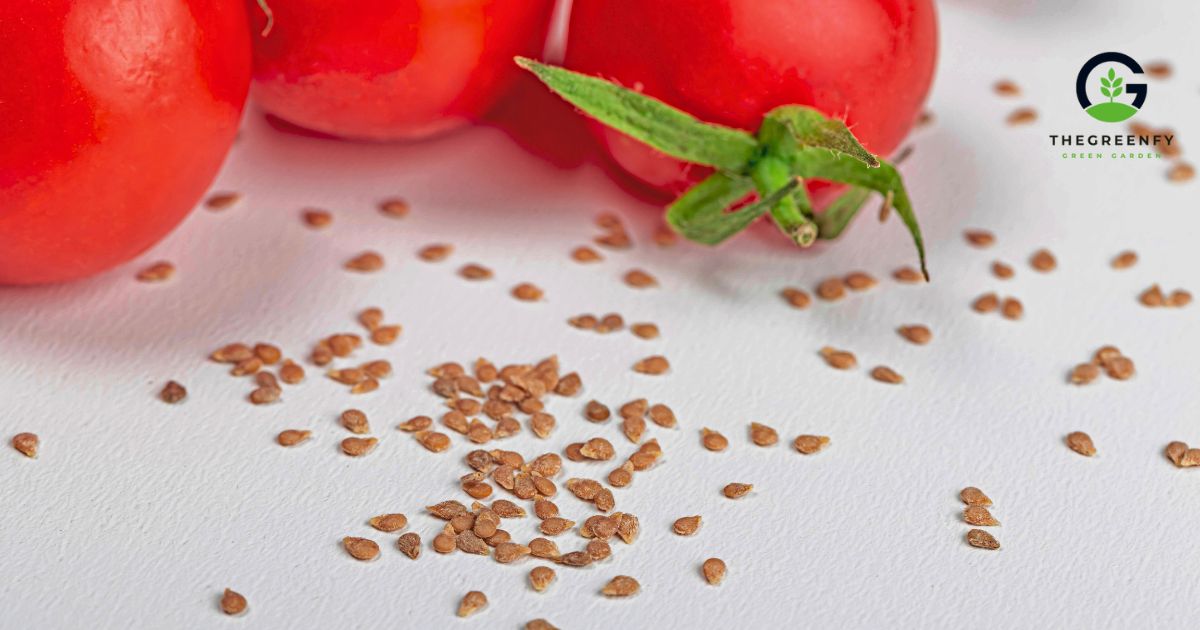Tomatoes are the heart of many dishes. From fresh salads to hearty pasta sauces, they’re everywhere. But have you ever wondered why some tomatoes taste sweeter, grow faster, or last longer? The answer often lies in the seeds.
In this blog post, we’ll break down the different types of tomato seeds. Whether you’re a backyard gardener, a homesteader, or a curious beginner, this guide will help you choose the right seeds for your needs.
Why Tomato Seeds Matter
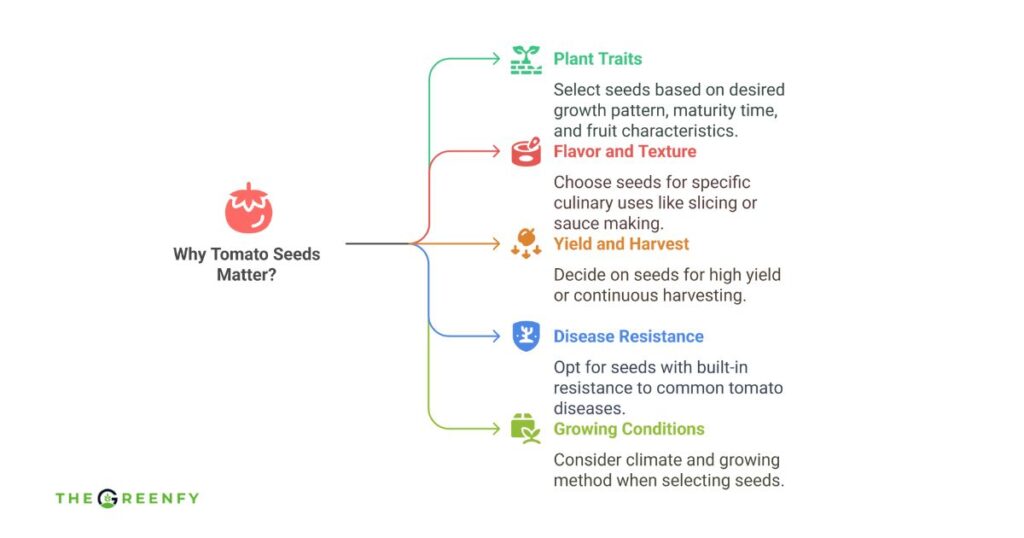
Tomato seeds are the blueprint of your tomato plant. Every fruit, vine, leaf, and root begins with a seed. But not all seeds are equal.
Whether you’re a hobby gardener or planting for a market garden, the type of tomato seed you choose will deeply impact how your plant grows, tastes, handles diseases, and how much fruit you actually get.
Let’s break this down in a way that’s easy to follow.
1. Seed Type Determines Plant Traits
Each tomato seed carries genetic instructions. These instructions decide things like:
- Growth pattern (bushy or vining)
- Time to maturity (how fast it grows)
- Fruit characteristics (size, color, texture, taste)
- Resistance to diseases or pests
- Tolerance to heat, drought, or cold
So, if you’re wondering why your friend’s tomato plant produced juicy, sweet tomatoes while yours didn’t, there’s a good chance it’s because of the seed.
2. Seed Choice Affects Flavor and Texture
Some seeds grow tomatoes perfect for slicing, others are ideal for sauces, and a few are best eaten straight off the vine.
- Heirloom seeds often give rich, unique flavors.
- Hybrid seeds offer consistent shape but may trade off some taste for other benefits.
- Paste tomato seeds produce drier, meatier tomatoes (hello, homemade marinara!).
This means the seed you choose depends on what you want to eat. Love fresh Caprese salads? Go with seeds that grow juicy slicers, making salsa or pizza sauce? Choose a paste tomato variety.
3. Yield and Harvest Depend on the Seed
Want a ton of tomatoes? Choose a high-yield hybrid seed.
Looking for a slower harvest over the summer for fresh use? Try indeterminate heirlooms.
- Some seeds are bred for quick harvests (great for short seasons).
- Others offer continuous harvesting for months (great for fresh eating).
- Some produce all at once, which is ideal for canning or preserving.
Your harvest goal should help shape your seed decision.
4. Disease Resistance Starts with the Seed
Tomato plants are prone to blights, wilts, viruses, and more. The good news is that some seeds are bred to fight these problems.
- Hybrid seeds often come with disease-resistant traits built in.
- Labels like “VFN” mean the plant resists Verticillium wilt, Fusarium wilt, and Nematodes.
Pro Tip: If you’ve had disease problems in your garden before, start with resistant seed varieties to save yourself heartache.
5. Your Growing Conditions Need the Right Seed
Tomato seeds also matter based on where you live and how you grow.
Ask yourself:
- Is my climate hot or cool?
- Do I have a short growing season?
- Will I grow in containers or open ground?
- Do I want to grow indoors or in a greenhouse?
Some tomato seeds are perfect for container gardening. Others grow massive vines that need staking and spacing. For cooler regions, early-maturing seeds are best. For warmer zones, you have more flexibility.
The 4 Main Types of Tomato Seeds (With Full Breakdown)
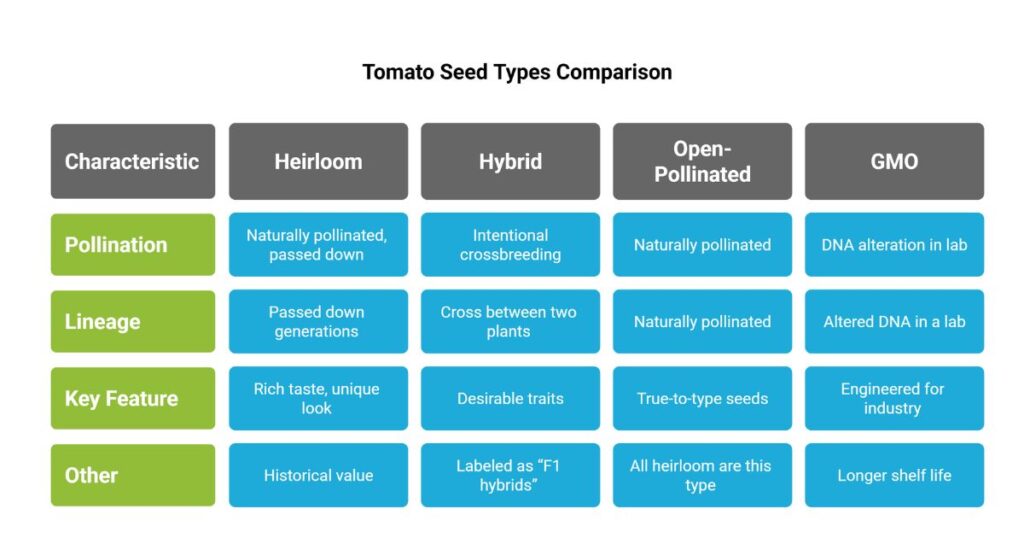
Choosing the right tomato seed can feel like standing in the middle of a giant produce aisle, everything looks great, but you don’t know which one to pick.
Understanding the four main types of tomato seeds Heirloom, Hybrid, Open-Pollinated, and Genetically Modified (GMO) helps you make the best decision for your garden, kitchen, and harvest goals.
Let’s examine each type in depth so you can confidently choose the seed that best suits your gardening style and tomato dreams.
1. Heirloom Tomato Seeds: Flavor with a Story
Heirloom tomato seeds are open-pollinated varieties passed down through generations, typically 50 years or more. These seeds are cherished for their rich taste, unique appearance, and historical value. Unlike modern hybrids, heirlooms are preserved naturally, without crossbreeding in labs or greenhouses.
Think of heirloom seeds as the grandma of all tomatoes full of wisdom, flavor, and tradition.
Key Characteristics:
- Open-pollinated: Naturally pollinated by bees, wind, or self.
- Genetically stable: When you save seeds, the offspring will be like the parent plant.
- Unique looks and flavors: Ranging from green-striped to black-skinned, heirlooms offer diversity you won’t find in store-bought tomatoes.
Popular Heirloom Varieties:
- Brandywine: Pinkish-red, large, sweet tomatoes.
- Cherokee Purple: Dark red with a smoky, rich flavor.
- Green Zebra: Bright green with yellow stripes and a tangy taste.
- Black Krim: Deep, dark red—almost black—with bold taste.
Pros of Heirloom Seeds:
- Outstanding flavor and texture
- Replantable seeds every year
- Huge variety and uniqueness
- Perfect for organic gardeners and small farms
Cons of Heirloom Seeds:
- Less disease resistance
- Lower yields in some cases
- Prone to cracking or bruising during shipping
- Slower growth compared to hybrids
“Heirloom tomatoes are like vintage wine—more time, care, and unforgettable results.”
2. Hybrid Tomato Seeds: Built for Performance
Hybrid seeds result from intentional crossbreeding between two different tomato plants to create a new plant with desirable traits from both parents. They are not genetically modified; they’re created through traditional plant breeding.
Hybrid seeds are labeled as “F1 hybrids” and are incredibly popular among commercial growers and home gardeners alike.
Key Characteristics:
- Controlled cross-pollination in greenhouses or farms
- Do not breed true: You can’t save hybrid seeds and expect the same results next year
- Engineered for uniformity, yield, and disease resistance
Popular Hybrid Varieties:
- Better Boy: Juicy and large, perfect for slicing.
- Early Girl: Fast-growing, ideal for short seasons.
- Celebrity: Great all-rounder, reliable in different climates.
- Big Beef: Giant, tasty tomatoes with strong plants.
Pros of Hybrid Seeds:
- Reliable, consistent harvests
- Shorter growing seasons
- Stronger plants with built-in resistance
- Great for beginners or small garden spaces
Cons of Hybrid Seeds:
- Can’t save seeds (plants won’t grow true to type)
- Sometimes less flavor than heirlooms
- Seeds can be more expensive
- Limited diversity compared to open-pollinated types
“Hybrid tomatoes are like smartphones—efficient, durable, and built for performance, but they lack the soul of the classics.”
3. Open-Pollinated Tomato Seeds: Nature’s Original Plan
Wind, bees, insects, or self-pollination naturally pollinate open-pollinated (OP) seeds. When grown in isolation from other varieties, they produce true-to-type seeds. If you save seeds from this year’s tomatoes and plant them next year, you’ll get the same kind of plant again.
All heirloom seeds are open-pollinated, but not all open-pollinated seeds are heirloom (heirlooms have a longer lineage).
Key Characteristics:
- Natural pollination methods
- Seed-saving friendly
- Greater variation and diversity than hybrids
Popular Open-Pollinated Varieties (Non-Heirloom):
- Roma: Great for sauces and drying.
- Ace 55: Low-acid, smooth-skinned tomatoes.
- Glacier: Cold-tolerant variety that grows early.
Pros of Open-Pollinated Seeds:
- Stable genetics for seed saving
- Good mix of diversity and reliability
- Easier to grow organically
- Ideal for gardeners who want self-sufficiency
Cons of Open-Pollinated Seeds:
- Less uniformity than hybrids
- Lower resistance to some diseases
- May need more care to avoid cross-pollination
“Open-pollinated seeds are like homemade bread—simple, honest, and perfect for those who like doing things their own way.”
4. Genetically Modified (GMO) Tomato Seeds: Engineered for Industry
GMO stands for Genetically Modified Organism. GMO tomato seeds are created by altering the plant’s DNA in a lab. Scientists insert specific genes from other organisms to give the tomato desired traits, like longer shelf life, resistance to certain pests, or improved growth under drought conditions.
The best-known GMO tomato was the Flavr Savr, introduced in the 1990s. It was designed to stay firm longer for shipping and storage.
Key Characteristics:
- Created in a lab using gene editing
- Not created by natural breeding
- Used almost exclusively in large-scale agriculture
GMO Tomato Seed Availability:
- Not typically available to home gardeners
- Controlled use in commercial farming
- Heavily regulated by governments
Pros of GMO Seeds:
- Maximize yield and reduce crop loss
- Efficient in large-scale monoculture farming
- Lower chemical use (in some cases)
Cons of GMO Seeds:
- Not available to the average gardener
- Ethical and environmental concerns
- Cannot save seeds due to patents
- Often require special growing licenses or agreements
Comparison Table: Types of Tomato Seeds
| Type | Seed Saving | Flavor | Disease Resistance | Best For | Pollination Method |
|---|---|---|---|---|---|
| Heirloom | Yes | Rich and unique | Low to moderate | Foodies, seed savers | Open (natural) |
| Hybrid | No | Mild to good | High | Beginners, high productivity | Manual cross-pollination |
| Open-Pollinated | Yes | True to the parent plant | Moderate | Organic gardens, small farms | Bees, wind, or self |
| GMO | No | Standard or altered | Very high | Commercial agriculture | Genetically altered in the lab |
How to Choose the Right Type of Tomato Seed
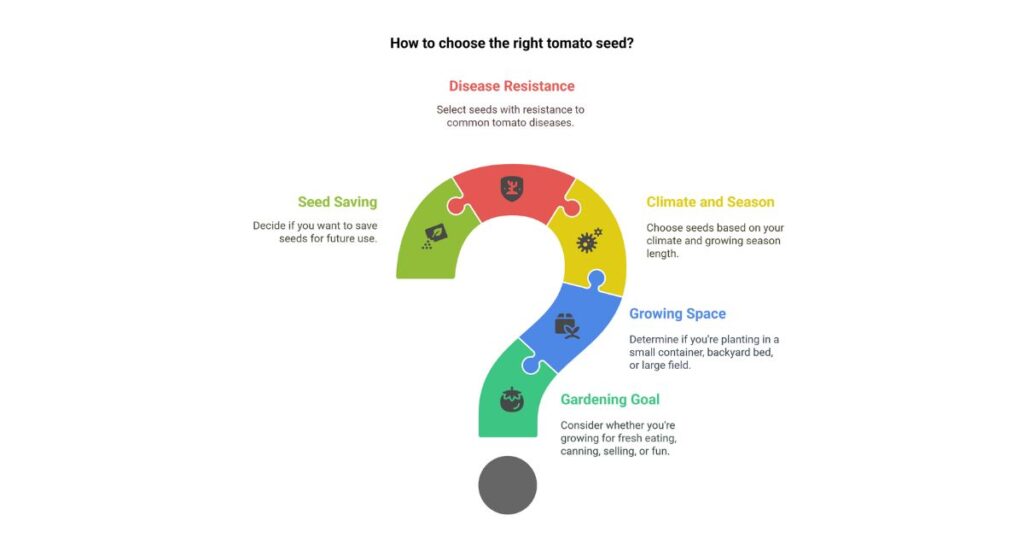
Choosing the right type of tomato seed doesn’t have to be complicated, but it does need a little thought. With hundreds of varieties, making the right decision depends on your goals, garden size, climate, and taste preferences.
Let’s simplify the process step by step.
1. Understand Your Gardening Goal
Ask yourself:
- Why am I growing tomatoes?
- Is it for fresh eating, canning, selling, or fun?
Here’s how your answer should guide your seed choice:
| Goal | Best Seed Type |
|---|---|
| Maximum harvest/yield | Hybrid |
| Best flavor | Heirloom |
| Saving seeds for next year | Open-pollinated/Heirloom |
| Organic or low-maintenance | Open-pollinated |
| Learning and experimenting | Mix of hybrid + heirloom |
Heirlooms are a delight if you’re growing for fun and flavor. But if you’re short on time and need something reliable, hybrids are your best friend.
2. Know Your Growing Space
Not all tomato plants grow the same way. You’ll need to know whether you’re planting in a small container, backyard bed, or large field.
- Small pots or patio gardens: Choose dwarf or determinate varieties (like ‘Patio Princess’ or ‘Roma’) and go with compact hybrids.
- In-ground backyard gardens: You have room for indeterminate varieties (like ‘Brandywine’ or ‘Big Beef’) that grow large and need staking.
- Greenhouses or long seasons: You can grow almost anything—go wild with heirlooms or experiment with open-pollinated types.
3. Consider Your Climate and Growing Season
Tomatoes are warm-season plants, but some grow faster and better in certain conditions.
- Short season (cooler climates):
- Look for early-maturing hybrids like ‘Early Girl’ or ‘Glacier’.
- Choose determinate types for quicker harvests.
- Long season (warmer climates):
- You can grow indeterminate heirlooms and enjoy a harvest that lasts months.
- Try flavorful varieties like ‘Black Krim’ or ‘Cherokee Purple’.
- Hot and dry climates:
- Go for heat-tolerant hybrids and small-fruited types like cherry or grape tomatoes.
Check the “Days to Maturity” on the seed packet. This tells you how long it’ll take from planting to harvest.
4. Look for Disease Resistance Codes
If you’ve dealt with tomato diseases in the past (or want to prevent problems), check the seed packet for resistance codes like:
- V – Verticillium wilt
- F – Fusarium wilt
- N – Nematodes
- T – Tobacco mosaic virus
- A – Alternaria
For example, a seed labeled “VFN” means the plant resists Verticillium, Fusarium, and Nematodes—great for beginners and humid climates.
5. Decide If You Want to Save Seeds
This one’s simple:
- If you want to save seeds, choose open-pollinated or heirloom seeds.
- If you don’t care about seed saving and want stronger plants, go with hybrids.
Avoid GMO seeds entirely for home gardening, as they’re usually unavailable for consumer use and can’t be saved legally.
What About Tomato Varieties?
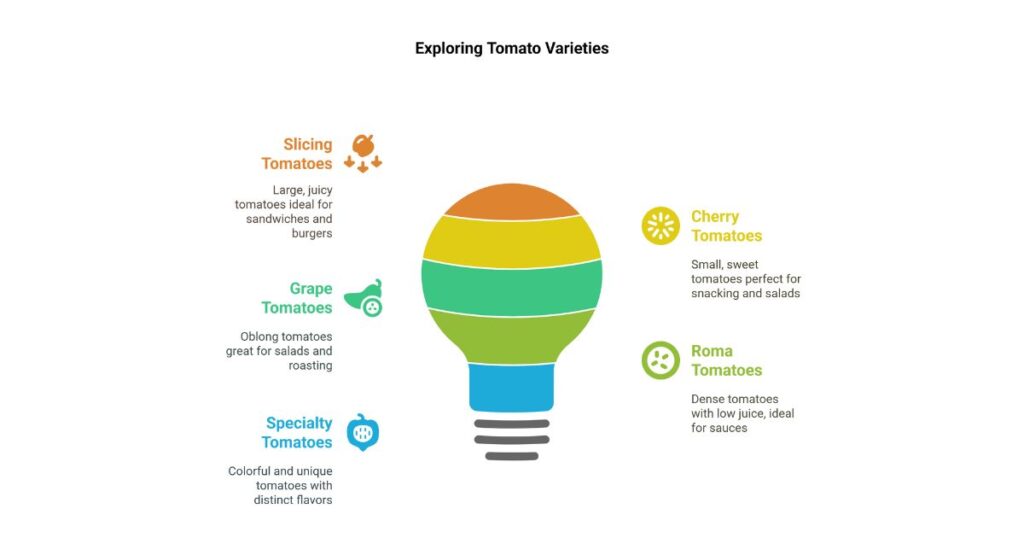
Now that you know about seed types, let’s look at tomato varieties. These are the types of tomatoes the seed grows into. Think of them as “flavors” within a seed category.
Here’s a breakdown of the most common tomato categories, so you can pick what works best for your meals and garden.
1. Slicing Tomatoes (Beefsteak Types)
Big, juicy, and perfect for sandwiches and burgers. These are usually large-fruited indeterminate plants.
- Best for: Fresh eating, sandwiches, burgers
- Popular varieties:
- Brandywine (Heirloom)
- Big Beef (Hybrid)
- Mortgage Lifter (Heirloom)
2. Cherry Tomatoes
Cherry tomatoes are small, bite-sized, and super sweet. They are great for kids and patio pots. Cherry tomatoes grow fast and bear fruit all season long.
- Best for: Snacking, salads, lunchboxes
- Popular varieties:
- Sweet 100 (Hybrid)
- Sungold (Hybrid)
- Black Cherry (Heirloom)
3. Grape Tomatoes
These are similar to cherry tomatoes but less watery and more oblong. They store longer and are great for roasting.
- Best for: Salads, roasting, snacks
- Popular varieties:
- Red Grape (Hybrid)
- Juliet (Hybrid)
4. Roma (Paste) Tomatoes
Roma-style tomatoes have dense flesh, low juice, and fewer seeds. They are perfect for cooking, canning, and making sauces.
- Best for: Pasta sauce, pizza sauce, tomato paste
- Popular varieties:
- Roma VF (Open-Pollinated)
- San Marzano (Heirloom)
- Amish Paste (Heirloom)
5. Specialty and Colorful Varieties
Tomatoes don’t have to be red. Try purple, orange, green, yellow, or even striped.
- Cherokee Purple (Heirloom): Deep reddish-purple with smoky flavor
- Green Zebra (Heirloom): Bright green with yellow stripes and tang
- Gold Medal (Heirloom): Big yellow fruit with red streaks
Color affects not only appearance but also taste, acidity, and sweetness.
Tips for Buying Tomato Seeds
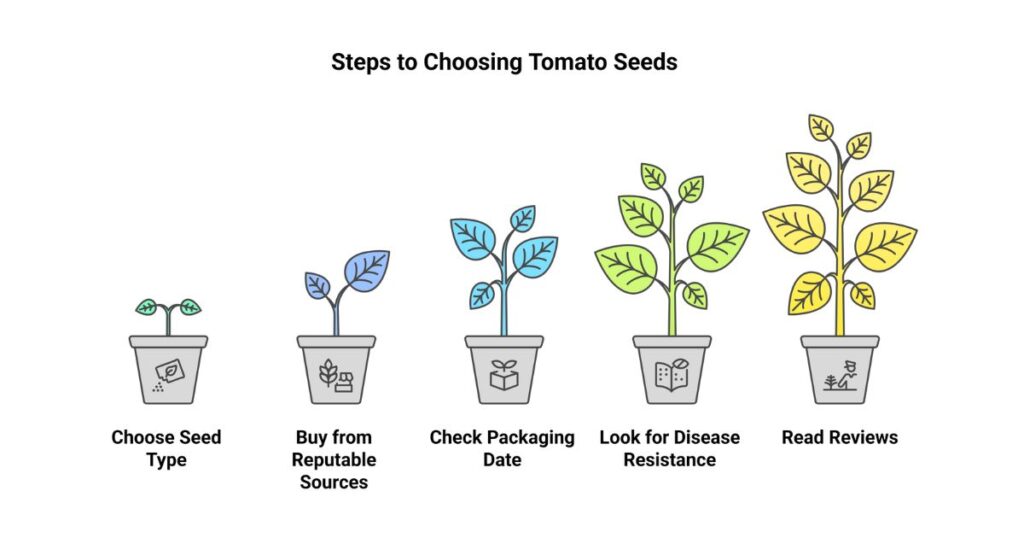
Buying tomato seeds might seem simple, but if you want the best harvest, flavor, and plant health, there are some important things to remember. Whether you’re a first-time or experienced gardener, smart seed selection can make a huge difference in your results.
Here are some practical, proven tips to help you buy the right tomato seeds for your garden:
1. Choose the Right Seed Type for Your Goals
Before you even shop, know what you’re looking for:
- Want to save seeds each year? Go for open-pollinated or heirloom seeds.
- Want easy and reliable plants? Choose hybrid seeds.
- Need disease resistance? Look for disease-coded hybrids (more below).
- Growing in pots or small spaces? Choose determinate (bush) varieties.
Don’t grab a seed packet because it says “juicy tomatoes.” Read the fine print.
2. Buy from Reputable Sources
Not all seed companies are created equal. Always buy from trusted sellers who specialize in gardening, agriculture, or heirloom varieties.
Recommended options:
- Local nurseries or gardening centers
- Certified organic seed sellers
- Trusted online seed companies (e.g., Baker Creek Heirloom Seeds, Johnny’s Selected Seeds, Seed Savers Exchange)
Why it matters: Cheap or unknown brands may sell old or low-quality seeds, which leads to poor germination and weak plants.
3. Check the Packaging Date and Germination Rate
Every seed packet should include:
- Packed for (Year) – Ensure it’s the current or previous season.
- Germination rate – Usually listed as a percentage. The higher, the better. Look for 80% or more.
- Batch/lot number – Helps in case of product recalls or issues.
Seeds do expire. Even if they’re kept dry, germination drops over time. Fresh seeds = stronger, healthier plants.
4. Look for Disease Resistance Codes
This is especially important if you’ve struggled with tomato diseases before. Look for these letters on the packet:
- V – Verticillium wilt
- F – Fusarium wilt
- N – Root-knot nematodes
- T – Tobacco mosaic virus
- A – Alternaria
- LB – Late blight
Example: A seed labeled VFN is resistant to Verticillium, Fusarium, and Nematodes.
5. Read Reviews and Ask for Recommendations
Still not sure which seed to pick?
- Read online reviews from gardeners in your area.
- Join Facebook gardening groups or forums like Reddit’s r/gardening.
- Ask local gardeners or extension services what grows well nearby.
Local advice can save you a lot of trial and error.
How to Store Tomato Seeds (If Saving)
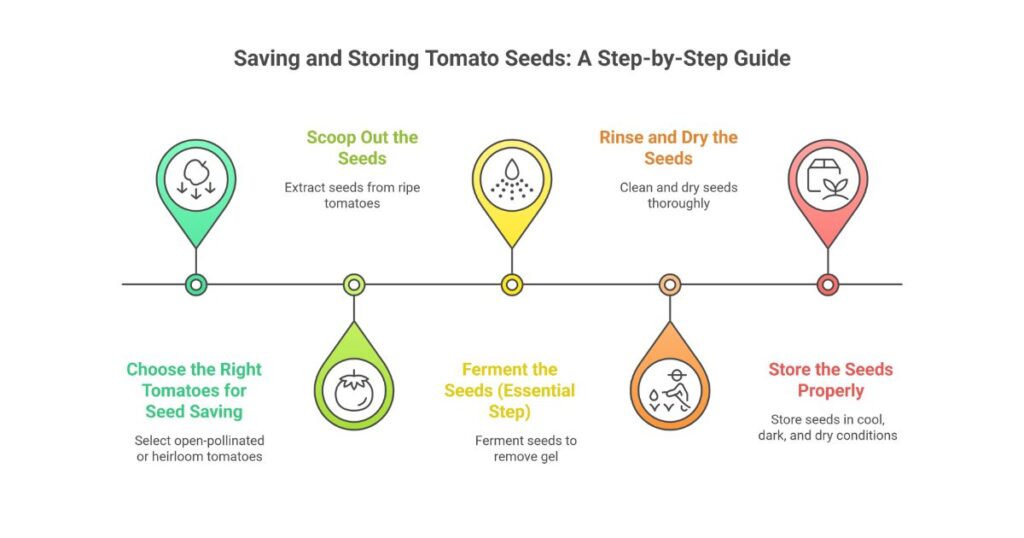
Saving tomato seeds is a great way to build self-sufficiency, grow your favorite varieties year after year, and save money. But it only works if you store the seeds correctly. Improper storage can ruin your efforts by reducing seed viability (germination rate) or causing mold.
Here’s a step-by-step guide to saving and storing your tomato seeds correctly.
Step 1: Choose the Right Tomatoes for Seed Saving
- Only save seeds from open-pollinated or heirloom tomatoes.
- Do not save hybrid seeds if you want consistent results—they will not grow true to the parent plant.
Pick a healthy, fully ripe tomato from a disease-free plant. Overripe tomatoes are even better for seed collection.
Step 2: Scoop Out the Seeds
- Cut the tomato across the middle (not through the stem).
- Scoop out the jelly-like pulp containing the seeds.
- Place it in a glass or jar. Don’t add water yet.
Step 3: Ferment the Seeds (Essential Step)
Tomato seeds are coated with a natural gel that inhibits germination. Fermentation removes this gel and kills some seed-borne diseases.
ow to ferment:
- Add a little water to the pulp in the jar.
- Cover loosely with a paper towel or cloth (to keep bugs out).
- Let it sit at room temperature for 2 to 3 days.
- Stir once daily.
- A moldy film will appear—this is normal!
Once fermentation is done, healthy seeds sink, and dead seeds float.
Step 4: Rinse and Dry the Seeds
Pour off the mold and floating gunk.
- Add fresh water, stir, and pour through a fine sieve.
- Place the clean seeds on a paper towel or coffee filter (avoid paper napkins—they stick).
- Let them dry in a cool, dry, and shady place for 5–7 days.
Spread them out evenly and label them so you don’t forget the variety.
Step 5: Store the Seeds Properly
Once the seeds are completely dry, store them in:
- Paper envelopes or small coin envelopes
- Glass jars with a silica gel pack (to absorb moisture)
- Airtight containers kept in a cool, dark place
Ideal storage conditions:
- Temperature: 32°F to 41°F (0°C to 5°C)
(Refrigerators work well, but avoid freezers.) - Humidity: Low (less than 50%)
Label your seeds with:
- Variety name
- Date saved
- Any notes (flavor, growth habit, etc.)
How Long Do Saved Tomato Seeds Last?
If stored correctly, tomato seeds can remain viable for 4 to 6 years, sometimes even longer!
But germination rate drops with time. For best results, aim to use saved seeds within 3 years.
Pro Tips for Seed Saving and Storage
- Always clean seeds thoroughly. Moisture causes mold.
- Don’t store seeds in plastic bags unless they’re completely dry.
- Use airtight containers in humid climates to prevent seed rot.
- Test germination after 1–2 years by planting 10 seeds in damp paper towels. If fewer than 6 sprout, the seed batch is aging.
Tomato Seed Myths—Busted!
There’s a lot of buzz about tomato seeds online, but not all of it is true. Whether from garden forums, social media, or a neighbor down the street, misinformation spreads fast. Let’s clear the air and bust some of the most common tomato seed myths.
Myth 1: Hybrid Seeds Are Genetically Modified (GMO)
False.
Hybrid seeds are created by natural cross-pollination between two different tomato plants. This process happens under controlled conditions to combine desirable traits, like size and disease resistance.
GMO seeds, on the other hand, are altered in a lab by inserting genes from other organisms. Hybrids = natural. GMOs = lab-made.
Myth 2: You Can Save Seeds From Any Tomato
Not always.
You can only reliably save seeds from open-pollinated or heirloom varieties. If you try to save seeds from a hybrid tomato, the new plant will likely be genetically unpredictable and may not resemble the parent.
If seed saving is your goal, skip hybrids and go for heirloom or open-pollinated seeds.
Myth 3: All Heirlooms Taste Better
Not necessarily.
Heirloom tomatoes are famous for their flavor, but not every variety will blow your taste buds away. Some heirlooms are bred for color, shape, or history, not just taste.
Taste also depends on soil, sun, water, and care. A poorly grown heirloom’s flavor will not match that of a well-grown hybrid.
Best Tomato Seeds for Beginners
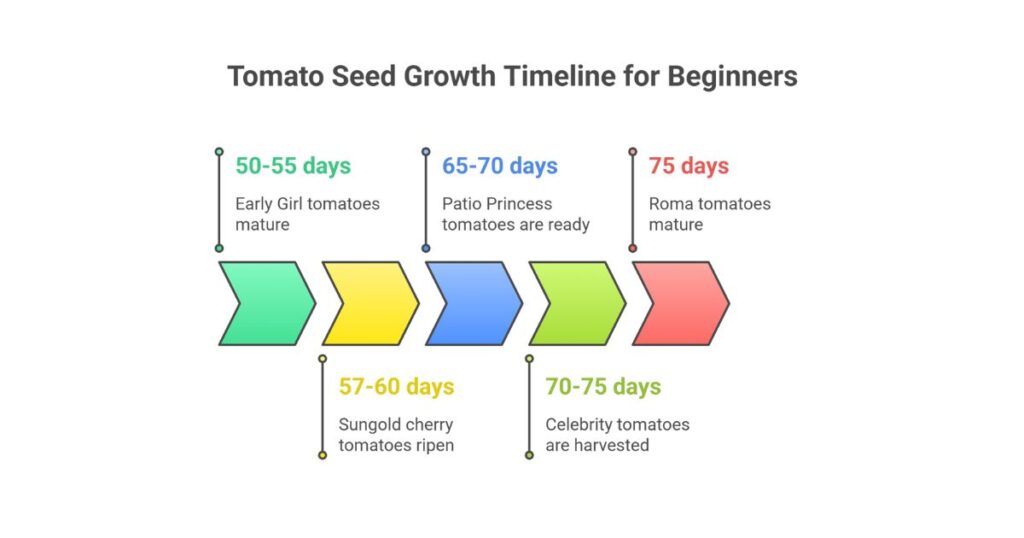
Starting as a gardener can feel overwhelming, but it doesn’t have to be. Some tomato seeds are easier to grow, making them perfect for first-timers. Our top beginner-friendly picks are based on ease, flavor, yield, and reliability.
1. Early Girl (Hybrid)
- Why it’s great: Fast grower, great taste, and widely available.
- Days to maturity: ~50-55 days
- Bonus: Handles cooler weather well.
2. Roma (Open-Pollinated)
- Why it’s great: Compact plants, perfect for sauce lovers.
- Days to maturity: ~75 days
- Bonus: Low in juice, high in flavor.
3. Sungold (Hybrid Cherry Tomato)
- Why it’s great: Super sweet cherry tomatoes grow like champs.
- Days to maturity: ~57-60 days
- Bonus: Kids love them!
4. Celebrity (Hybrid)
- Why it’s great: Disease-resistant and reliable.
- Days to maturity: ~70-75 days
- Bonus: Consistent yield and firm fruits.
5. Patio Princess (Hybrid Dwarf)
- Why it’s great: Grows well in pots and small spaces.
- Days to maturity: ~65-70 days
- Bonus: No staking required.
Final Thoughts
Picking tomato seeds isn’t just about planting. It’s about what kind of experience you want. Do you want the rich, deep flavors of heirloom? The reliable harvests of hybrids? Or the joy of seed-saving with open-pollinated seeds?
Whatever your goal, there’s a seed type out there for you.
Start small, grow what you love, and enjoy every bite. 🍅
